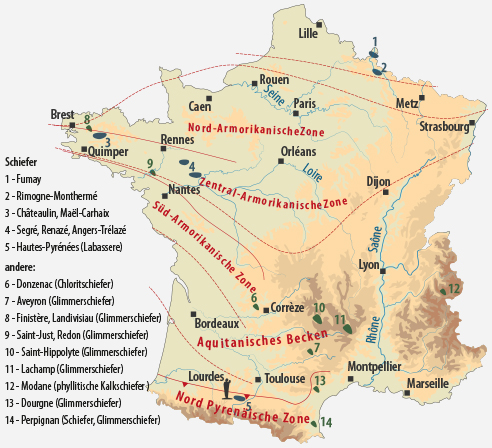|
Slate deposits of the Armorican Massif - Angers (France)
Within the Armorican Massif the Middle- to Upper-Ordovician slates of Angers as well as the Lower-Carboniferous Kulm slates of Maël-Carhaix are the two important slate deposits.
The Armorican Massif comprises the Normandie, Bretagne and Vendee. Towards east it runs below the Mesozoic-Tertiary series of the Aquitanian basin and the shelf of Biscaya covers the Armorican Massif in SW.
During the Paleozoic the Armorican Massif was the northern part of the northern margin of Gondwana. With the beginning Arenigian a large part of the North- and Central Armorican Massif, including the synclines of Segré and Angers with its roofing slate deposits, was floated. In this shallow-marine environment the 'Grès Armorican Formation' was deposited and contains mainly sandstones with intercalations of slate. During the Arenigian, partly to Llandeilian or Upper-Caradocian, respectively, the transgression reaches its peak and led to the sedimentation of the roofing slate bearing 'Angers Formation'. This sedimentary environment is characterised by an shallow-marine facies within an open shelf.
The geographic position of the shelf sediments during the Llanvirnian indicates a coastal sedimentation environment in the northern part and a distal and probably deeper sedimentary environment in the southern direction (Robardet et al. In: Keppie, 1994). Within the Armorican Massif four orogenic phases can be distinguished (Rolet In: Keppie, 1994):
Cadomic orogeny early Cambrian-Ordovician extensional events and plutons Eo-Hercynian closure and collision from Silurian to Devonian Hercynian intracratonic, post-collisional phase, which mainly governed the origin of the roofing slates of Angers and Maël-Carhaix
At the end of the Devonian the collision processes had already started (Bretonic Phase). All Lower-Carboniferous units were almost completely transformed to the Armorican Massif and the little remaining 'intramontan' Carboniferous basins had no access to the norther ocean. Two orogenic periods with different types of basins can be separated:
-
Basins of the Lower-Carboniferous (Tournaisian, Viséan to Namurian) represented by the basin of Châteaulin-Laval with the slates of Maël-Carhaix as well as the basins of Ancenis, Morlaix and Montmartin.
-
Basins of the Middle- and Upper Carboniferous (Westphalian to Stephanian) with its sporadic narrow coal-graben, which are strongly related to the tectonic regime of the South-Armorican shear zone (SASZ).

French slate districts. Other: Glimmerschiefer (mica schist).
The Slates of Angers
The primary Middle- to Upper-Ordovician slates in the region of Angers and Segré are situated within the 'basin d'Anjou', with WNW-ESE striking anticlines and synclines. Three slate deposits can be separated and all were mined subsurface:
1. Trélazé, east of Angers with the mines of Les Fresnais. Kerouanton
(1991) mentioned here also the slate mines of Avrillé, La Pouêze,
Angrie, Vritz, Le Grand Auverné, Moisdon-la-Rivière, Derval and
Pierric.
2. Noyant, west of Segré, about 31 mi. north-west of Angers. Kerouanton
(1991) mentioned the slate mines of Noyant-la-Gravoyère, Combrée, Fercé and Rougé.
Angers - Trelazé
The mines of Trelazé are aligned WNW-ESE and thus they copy the syncline of Angers-Trelazé. This syncline consist of two synclines separated by an anticline and the slates are mined within the unit "schistes d'Angers" in two different Niveaus:
Niveau Ardoisier Inférieur, Niveau Ardoisier Intermédiare.
This two levels are separated by a 328 ft. thick non minable slate series. Depending on the position within the syncline different slate layers with different lithological properties are distinguished (Marty, 1980):
-
Niveau Ardoisier Intermédiare: 'Veine Nord' and 'Veine Extrême Nord'
-
Niveau Ardoisier Inférieur: 'Veines Intermédiare', 'Veine Sud', 'Veine Extrême Sud' and 'Carrière Napoléon'
The slates 'Ardoisier Inférieur' show a thickness between 32-98 ft. with a very fine grained sedimentary pattern. At the bottom it is bordered by the 'Ricard'-facies and at the top by the 'Foriace'-facies. Typical for the 'Ricard'-facies is the occurrence of pyritized fossils whereas the 'Foriace'-facie shows knotted pyrites as well as branched pyritizations on the splitting plane.
Because of the very fine grained sedimentary pattern and the well developed fracture cleavage plane of the 'Ardoisier Inférieur' this slates can be split to 3 mm (= 0.12 in.) thin shingles.
The slates 'Ardoisier Intermédiare' consist of two slate layers, separated by 33 ft. thick sandy unit. The first slate layer 'Veine Nord' shows a relative constant thickness of 131-148 ft. and the second slate layer 'Veine Extrême Nord' is between 33-82 ft. thick with varying fine- and coarse grained parts.
Novant-Segré
As in Trelazé the slates 'Ardoisier Inférieur' and 'Ardoisier Intermédiare' occur also in this area but only in the first one slate was mined. The slates are within the WNW-ESE striking syncline of Segré and the fanning fracture cleavage dips 80°-85° to North. Numerous WNW-SSE striking faults cross the syncline and lead to a alternating slate quality (Marty, 1980).
The slates 'Ardoisier Intermédiare' are mined at Noyant and Bel Air and show a thickness of about 262 ft. in the vicinity of Noyant. At the bottom it is limited by a black fossil rich slate containing pyrite nodules. At the top it gradually changes to a more and more sandy and micaceous slate.
The 262 ft. thick slates are divided in 33-98 ft. thick single slate beds with varying quality. The slates are generally not as fine grained as those from Trelazé and contain more well crystallized cubes of pyrite which are homogeneously distributed and easily oxidable. This slate deposits allow the mining of large slate pieces.
The slate 'Ardoisier Inférieur' was discovered by drilling in 1995 and shows a thickness between 82-98 ft. It is less pyrite bearing and clearly more fine grained as the slate 'Ardoisier Intermédiare' but seems to be more jointed.
Pictures
Move mouse over thumb to enlarge.
|

